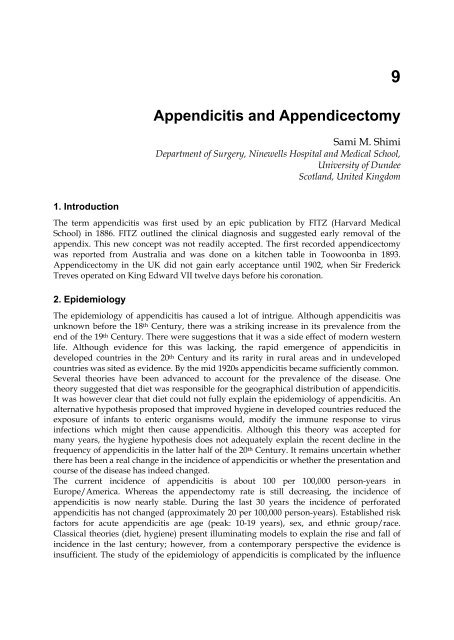UPDATED TOPICS IN MINIMALLY INVASIVE ABDOMINAL SURGERY
UPDATED TOPICS IN MINIMALLY INVASIVE ABDOMINAL SURGERY
UPDATED TOPICS IN MINIMALLY INVASIVE ABDOMINAL SURGERY
You also want an ePaper? Increase the reach of your titles
YUMPU automatically turns print PDFs into web optimized ePapers that Google loves.
1. Introduction<br />
Appendicitis and Appendicectomy<br />
9<br />
Sami M. Shimi<br />
Department of Surgery, Ninewells Hospital and Medical School,<br />
University of Dundee<br />
Scotland, United Kingdom<br />
The term appendicitis was first used by an epic publication by FITZ (Harvard Medical<br />
School) in 1886. FITZ outlined the clinical diagnosis and suggested early removal of the<br />
appendix. This new concept was not readily accepted. The first recorded appendicectomy<br />
was reported from Australia and was done on a kitchen table in Toowoonba in 1893.<br />
Appendicectomy in the UK did not gain early acceptance until 1902, when Sir Frederick<br />
Treves operated on King Edward VII twelve days before his coronation.<br />
2. Epidemiology<br />
The epidemiology of appendicitis has caused a lot of intrigue. Although appendicitis was<br />
unknown before the 18 th Century, there was a striking increase in its prevalence from the<br />
end of the 19 th Century. There were suggestions that it was a side effect of modern western<br />
life. Although evidence for this was lacking, the rapid emergence of appendicitis in<br />
developed countries in the 20 th Century and its rarity in rural areas and in undeveloped<br />
countries was sited as evidence. By the mid 1920s appendicitis became sufficiently common.<br />
Several theories have been advanced to account for the prevalence of the disease. One<br />
theory suggested that diet was responsible for the geographical distribution of appendicitis.<br />
It was however clear that diet could not fully explain the epidemiology of appendicitis. An<br />
alternative hypothesis proposed that improved hygiene in developed countries reduced the<br />
exposure of infants to enteric organisms would, modify the immune response to virus<br />
infections which might then cause appendicitis. Although this theory was accepted for<br />
many years, the hygiene hypothesis does not adequately explain the recent decline in the<br />
frequency of appendicitis in the latter half of the 20 th Century. It remains uncertain whether<br />
there has been a real change in the incidence of appendicitis or whether the presentation and<br />
course of the disease has indeed changed.<br />
The current incidence of appendicitis is about 100 per 100,000 person-years in<br />
Europe/America. Whereas the appendectomy rate is still decreasing, the incidence of<br />
appendicitis is now nearly stable. During the last 30 years the incidence of perforated<br />
appendicitis has not changed (approximately 20 per 100,000 person-years). Established risk<br />
factors for acute appendicitis are age (peak: 10-19 years), sex, and ethnic group/race.<br />
Classical theories (diet, hygiene) present illuminating models to explain the rise and fall of<br />
incidence in the last century; however, from a contemporary perspective the evidence is<br />
insufficient. The study of the epidemiology of appendicitis is complicated by the influence














![focuspdca.ppt [Compatibility Mode]](https://img.yumpu.com/22859457/1/190x146/focuspdcappt-compatibility-mode.jpg?quality=85)


